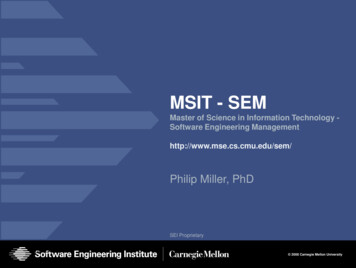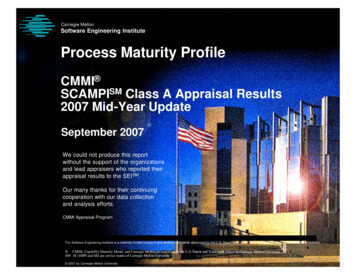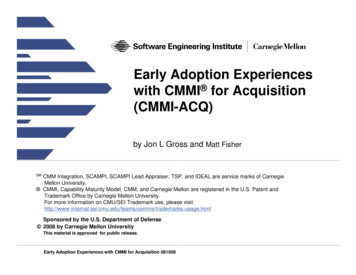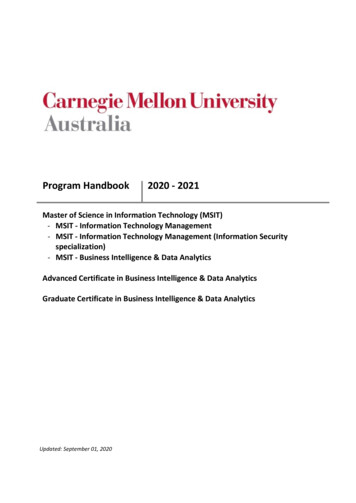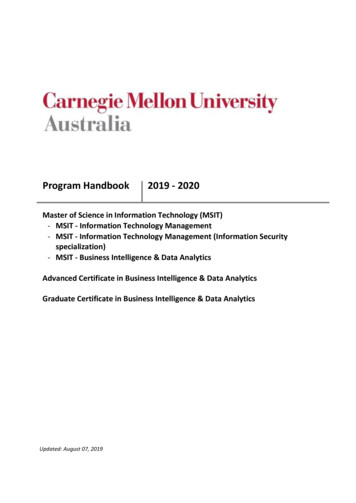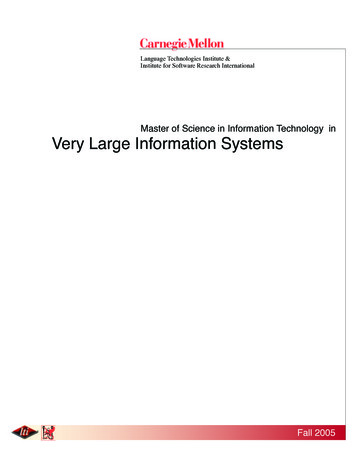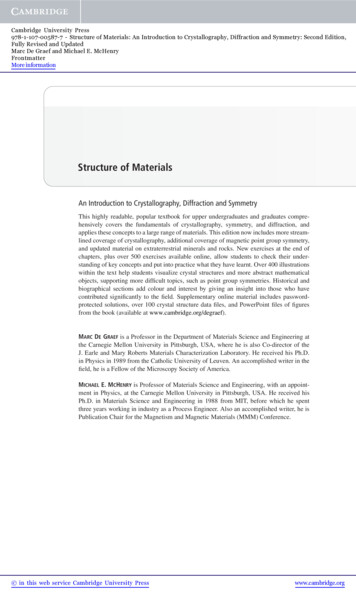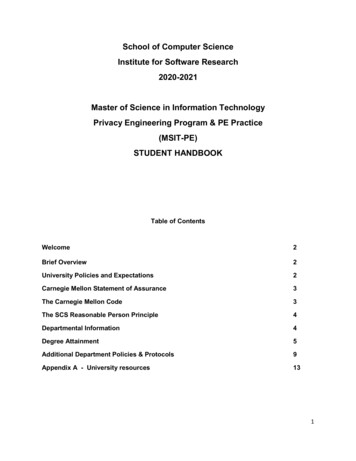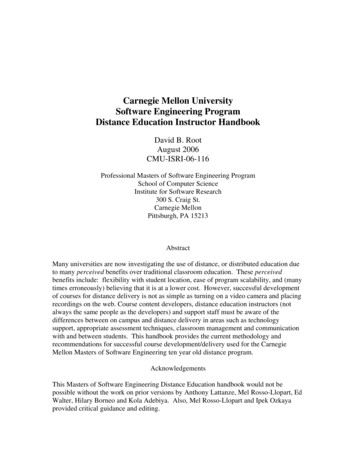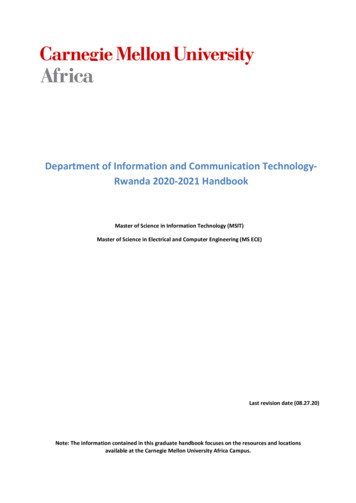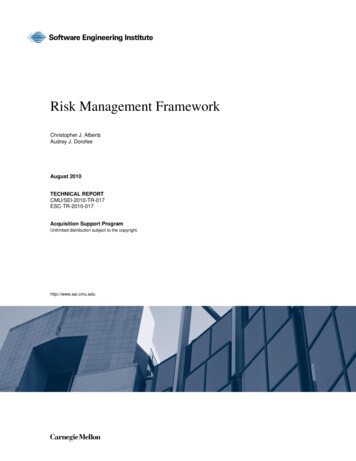
Transcription
Risk Management FrameworkChristopher J. AlbertsAudrey J. DorofeeAugust 2010TECHNICAL n Support ProgramUnlimited distribution subject to the copyright.http://www.sei.cmu.edu
This report was prepared for theSEI Administrative AgentESC/XPK5 Eglin StreetHanscom AFB, MA 01731-2100The ideas and findings in this report should not be construed as an official DoD position. It is published in the interest ofscientific and technical information exchange.This work is sponsored by the U.S. Department of Defense. The Software Engineering Institute is a federally fundedresearch and development center sponsored by the U.S. Department of Defense.Copyright 2010 Carnegie Mellon University.NO WARRANTYTHIS CARNEGIE MELLON UNIVERSITY AND SOFTWARE ENGINEERING INSTITUTE MATERIAL ISFURNISHED ON AN “AS-IS” BASIS. CARNEGIE MELLON UNIVERSITY MAKES NO WARRANTIES OF ANYKIND, EITHER EXPRESSED OR IMPLIED, AS TO ANY MATTER INCLUDING, BUT NOT LIMITED TO,WARRANTY OF FITNESS FOR PURPOSE OR MERCHANTABILITY, EXCLUSIVITY, OR RESULTS OBTAINEDFROM USE OF THE MATERIAL. CARNEGIE MELLON UNIVERSITY DOES NOT MAKE ANY WARRANTY OFANY KIND WITH RESPECT TO FREEDOM FROM PATENT, TRADEMARK, OR COPYRIGHT INFRINGEMENT.Use of any trademarks in this report is not intended in any way to infringe on the rights of the trademark holder.Internal use. Permission to reproduce this document and to prepare derivative works from this document for internal useis granted, provided the copyright and “No Warranty” statements are included with all reproductions and derivativeworks.External use. This document may be reproduced in its entirety, without modification, and freely distributed in written orelectronic form without requesting formal permission. Permission is required for any other external and/or commercialuse. Requests for permission should be directed to the Software Engineering Institute at permission@sei.cmu.edu.This work was created in the performance of Federal Government Contract Number FA8721-05-C-0003 with CarnegieMellon University for the operation of the Software Engineering Institute, a federally funded research and developmentcenter. The Government of the United States has a royalty-free government-purpose license to use, duplicate, or disclosethe work, in whole or in part and in any manner, and to have or permit others to do so, for government purposes pursuantto the copyright license under the clause at 252.227-7013.For information about SEI publications, please visit the library on the SEI website (www.sei.cmu.edu/library).
Table of Risk Management Concepts53Framework Overview94Prepare for Risk Management (Phase 1)155Perform Risk Management Activities (Phase 2)5.1 Assess Risk (Activity 2.1)5.2 Plan for Risk Mitigation (Activity 2.2)5.3 Mitigate Risk (Activity 2.3)192427316Sustain and Improve Risk Management (Phase 3)357Framework Requirements39Appendix: Evaluating a Risk Management Practice45References/Bibliography59i CMU/SEI-2010-TR-017
ii CMU/SEI-2010-TR-017
List of FiguresFigure 1:Components of Risk6Figure 2:Risk Management Activities7Figure 3:Framework Structure9Figure 4:Structure of Dataflow Diagrams11Figure 5:Dataflow for Phase 115Figure 6:Dataflow for Phase 219Figure 7:Dataflow for Activity 2.124Figure 8:Dataflow for Activity 2.227Figure 9:Dataflow for Activity 2.331Figure 10:Dataflow for Phase 335iii CMU/SEI-2010-TR-017
iv CMU/SEI-2010-TR-017
AcknowledgmentsThe authors would like to thank the Army Strategic Software Improvement Program (ASSIP) for piloting a workshop that resulted in significant improvements to the framework. The authors also wish toacknowledge the contributions of the reviewers, Carol Woody, Julie Cohen, and Tricia Oberndorf, andthe editor of this technical report, Barbara White.v CMU/SEI-2010-TR-017
vi CMU/SEI-2010-TR-017
AbstractAlthough most programs and organizations use risk management when developing and operating software-reliant systems, preventable failures continue to occur at an alarming rate. In many instances, theroot causes of these preventable failures can be traced to weaknesses in the risk management practicesemployed by those programs and organizations. To help improve existing risk management practices,Carnegie Mellon University Software Engineering Institute (SEI) researchers undertook a project todefine what constitutes best practice for risk management. The SEI has conducted research and development in the area of risk management since the early 1990s. Past SEI research has applied risk management methods, tools, and techniques across the life cycle (including acquisition, development, andoperations) and has examined various types of risk, including software development risk, system acquisition risk, operational risk, mission risk, and information security risk, among others.In this technical report, SEI researchers have codified this experience and expertise by specifying (1) aRisk Management Framework that documents accepted best practice for risk management and (2) anapproach for evaluating a program’s or organization’s risk management practice in relation to theframework.vii CMU/SEI-2010-TR-017
viii CMU/SEI-2010-TR-017
1 IntroductionOccurrence ofPreventable FailuresAlthough most programs and organizations use risk management whendeveloping and operating software-reliant systems, preventable failurescontinue to occur at an alarming rate. Several reasons contribute to the occurrence of these failures, includingsignificant gaps in the risk management practices employed by programsand organizationsuneven and inconsistent application of risk management practices withinand across organizationsineffective integration of risk management with program and organizational managementincreasingly complex management environmentTo help improve existing risk management practices, Carnegie MellonSoftware Engineering Institute (SEI) researchers undertook a project todefine what constitutes best practice for risk management. This technicalreport provides the results of that research project by specifying the following:a Risk Management Framework that documents accepted best practicefor risk managementan approach for evaluating a program’s or organization’s risk management practice in relation to the requirements specified in the frameworkSEI Background inRisk ManagementSince the early 1990s, the SEI has conducted research and development inthe area of risk management and has applied risk management methods,tools, and techniques across the life cycle (including acquisition, development, and operations). In addition, past SEI research examined varioustypes of risk, including software development risk [Dorofee 1996, Williams1999, Alberts 2009], system acquisition risk [Gallagher 1999], operationalrisk [Gallagher 2005], mission risk [Alberts 2009] and information security risk [Alberts 2002], among others. In this technical report, SEI researchers have codified this experience in the form of a Risk ManagementFramework.Carnegie Mellon is registered in the U.S. Patent and Trademark Office by Carnegie Mellon University.1 CMU/SEI-2010-TR-017
Risk ManagementFrameworkThe Risk Management Framework specifies accepted best practice for thediscipline of risk management. The framework is implementation independent—it defines key risk management activities, but does not specify howto perform those activities. In particular, the framework helps provide afoundation for a comprehensive risk management methodologybasis for evaluating and improving a program’s risk management practiceThe Risk Management Framework can be applied in all phases of the system development life cycle (e.g., acquisition, development, operations). Inaddition, the framework can be used to guide the management of manydifferent types of risk (e.g., acquisition program risk, software developmentrisk, operational risk, information security risk).Purpose of thisDocumentThe purpose of this technical report is to present the Risk ManagementFramework, which defines the core set of activities and outputs required tomanage risk effectively. However, this document does not provide step-bystep procedures for conducting the risk management activities. Other SEIdocuments and courses provide specific methods, tools, and techniques formanaging different types of risk.Intended AudienceThe primary audience for this technical report is people who are responsible for assessing and managing risk in development and operational settings. People who are interested in the following topics might also find thisdocument useful:learning about what constitutes best practice in risk managementevaluating and improving an existing risk management practice2 CMU/SEI-2010-TR-017
Structure of ThisDocumentThis technical report is divided into the following parts:Section 1: Introduction—provides a brief overview of the motivationfor developing the Risk Management Framework and defines the audience for this documentSection 2: Risk Management Concepts—presents background information about risk managementSection 3: Framework Overview—describes how the Risk Management Framework is structuredSection 4: Prepare for Risk Management (Phase 1)—presents activities that are required to prepare for risk managementSection 5: Perform Risk Management Activities (Phase 2)—describes activities that are required to manage risk effectivelySection 6: Sustain and Improve Risk Management (Phase 3)—presents activities that are required to sustain and improve a risk management practice over timeSection 7: Framework Requirements—defines the criteria that areused to establish conformance with the Risk Management FrameworkAppendix: Evaluating a Risk Management Practice—presents a setof worksheets that can be used to evaluate a program’s or organization’srisk management practice and establish consistency with the Risk Management Framework3 CMU/SEI-2010-TR-017
4 CMU/SEI-2010-TR-017
2 Risk Management ConceptsMultiple Contexts ofRisk ManagementThe term risk is used universally, but different audiences often attach different meanings to it [Kloman 1990]. In fact, the details about risk and howit supports decision making depend upon the context in which it is applied[Charette 1990]. For example, safety professionals view risk managementin terms of reducing the number of accidents and injuries. A hospital administrator views risk as part of the organization’s quality assurance program, while the insurance industry relies on risk management techniqueswhen setting insurance rates. Each industry thus uses a definition that isuniquely tailored to its context. No universally accepted definition of riskexists.Three Conditionsof RiskWhereas specific definitions of risk might vary, a few characteristics arecommon to all definitions. For risk to exist in any circumstance, the following three conditions must be satisfied [Charette 1990]:Basic Definition ofRisk11.The potential for loss must exist.2.Uncertainty with respect to the eventual outcome must be present.13.Some choice or decision is required to deal with the uncertainty andpotential for loss.These three characteristics can be used to forge a very basic definition ofthe word risk. Most definitions focus on the first two conditions—loss anduncertainty—because they are the two measurable aspects of risk. Thus, theessence of risk, no matter what the domain, can be succinctly captured bythe following definition: Risk is the possibility of suffering loss [Dorofee1996].Some researchers separate the concepts of certainty (the absence of doubt), risk (where the probabilities of alternativeoutcomes are known), and uncertainty (where the probabilities of possible outcomes are unknown). However, becauseuncertainty is a fundamental attribute of risk, we do not differentiate between decision making under risk and decisionmaking under uncertainty in this technical report.5 CMU/SEI-2010-TR-017
Components of RiskAs illustrated in Figure 1, a risk can be thought of as a cause-and-effectpair, where the threat is the cause and the resulting consequence is the effect. In this context, a threat is defined as a circumstance with the potentialto produce loss, while a consequence is defined as the loss that will occurwhen a threat is realized [Alberts tFigure 1: Components of RiskRisk MeasuresThree measures are associated with a risk: (1) probability, (2) impact, and(3) risk exposure. The relationships between probability and impact and thecomponents of risk are shown in Figure 1. In this context, probability isdefined as a measure of the likelihood that a threat will occur, while impactis defined as a measure of the loss that will occur if the threat is realized.Risk exposure provides a measure of the magnitude of a risk based on current values of probability and impact.Risk ManagementRisk management is a systematic approach for minimizing exposure to potential losses. It provides a disciplined environment forcontinuously assessing what could go wrong (i.e., assessing risks)determining which risks to address (i.e., setting mitigation priorities)implementing actions to address high-priority risks and bring those riskswithin tolerance6 CMU/SEI-2010-TR-017
Risk ManagementActivitiesFigure 2 illustrates the three core risk management activities:assess risk—transform the concerns people have into distinct, tangiblerisks that are explicitly documented and analyzedplan for risk mitigation—determine an approach for addressing or mitigating each risk; produce a plan for implementing the approach2mitigate risk—deal with each risk by implementing its defined mitigation plan and tracking the plan to completionThese three activities form the foundation of the Risk Management Framework.a tetigMiPlanAssessFigure 2: Risk Management Activities2No universal definition for the term mitigation exits. In fact, various risk management standards and guidelines use thisterm quite differently. In this report, we define mitigation broadly as any action taken to address a risk.7 CMU/SEI-2010-TR-017
Issue/ProblemOne of the fundamental conditions of risk is uncertainty regarding its occurrence. A risk, by definition, might or might not occur. In contrast, anissue3 (also referred to as a problem in many contexts) is a loss or adverseconsequence that has occurred or is certain to occur. With an issue, no uncertainty exists—the loss or adverse consequence has taken place or is certain to take place.4 Issues can also lead to (or contribute to) other risks bycreating a circumstance that produces a new threatmaking an existing threat more likely to occuraggravating the consequences of existing risksOpportunityRisk is focused on the potential for loss; it does not address the potential forgain. The concept of opportunity is used to address the potential for gain.An opportunity is the likelihood of realizing a gain from an allocation orreallocation of resources. Opportunity defines a set of circumstances thatprovides the potential for a desired gain and requires an investment or action to realize that gain (i.e., to take advantage of the opportunity). Pursuitof an opportunity can produce new risks or issues, and it can also changeexisting risks or issues.Focus of the RiskManagementFrameworkThe Risk Management Framework (hereafter also referred to as “theframework”) defines activities that are required to manage risk effectively.Activities for managing issues and opportunities are not explicitly specifiedin the Risk Management Framework. While risk management can be integrated with issue and opportunity management [Alberts 2009], the detailsfor achieving an integrated approach for managing risks, issues, and opportunities is beyond the scope of this report.3People do not always find it easy to distinguish between an issue and the future risk posed by that issue (if left uncorrected). This confusion can result in issues being documented in a risk database and being treated like risks (and viceversa). Management must take great care to ensure that their approaches for managing issues and risks are integratedappropriately and understood by both management and staff.4Many of the same tools and techniques can be applied to both issue and risk management.8 CMU/SEI-2010-TR-017
3 Framework OverviewIntroductionThis section presents an overview of the Risk Management Framework. Figure3 shows the three phases of the framework. The main goal of the framework isto specify the core sequence of activities that must be executed when performing risk management (Phase 2). However, because risk management must beconducted within a broader context or environment, the framework also specifies activities to prepare for risk management (Phase 1) as well as to sustainand improve the risk management practice over time (Phase 3).Phase 1Prepare for RiskManagementPhase 2Perform RiskManagement ActivitiesPhase 3Sustain and ImproveRisk ManagementFigure 3: Framework StructureRisk ManagementFramework: ThreePhases9 CMU/SEI-2010-TR-017Phase 1 (“Prepare for Risk Management”) is used to get ready for the other twophases. Phase 1 activities should be complete before activities in the otherphases are executed. Phase 2 (“Perform Risk Management Activities”) definesa set of activities for managing risk. Phase 2 activities are continually performed to ensure that the overall risk to key objectives is effectively managedover time. The activities of Phase 3 (“Sustain and Improve Risk Management”)are normally performed on a periodic basis to ensure that the risk managementpractice remains effective over time. Phase 3 activities are used to identify improvements to a risk management practice. While Phase 1 is generally completed prior to beginning the other two, Phases 2 and 3 are typically executedconcurrently.
SpecifyingFramework PhasesThe following common elements are used to specify each phase of theframework:description of the phasekey questions answered by the phasedataflow for the phase that highlights the phase’s inputs, constraints,resources, and outputsdescription of each input required by the activities performed in thephasedescription of each constraint affecting activities performed in the phasedescription of each resource required by activities performed in thephasedescription of each output produced by the activities performed in thephasedescription of each activity that must be performed in the phaseSpecifying Phase 2ActivitiesPhase 2 is described in more detail than the other phases because it specifies the distinct sequence of activities that uniquely defines a risk management practice. Phase 2 of the framework comprises the following three activities:Activity 2.1: Assess RiskActivity 2.2: Plan for Risk MitigationActivity 2.3: Mitigate RiskThe following common elements are used to specify each Phase 2 activity:description of the activitykey questions answered by the activitydataflow of inputs and outputs for the activitydescriptions of each input to the activitydescriptions of each output produced by the activitycircumstances that trigger execution of the activitydescription of each sub-activity that must be performed when conductingthe activity10 CMU/SEI-2010-TR-017
Dataflow DiagramsDataflow diagrams are used to document phases and activities in the RiskManagement Framework. Figure 4 shows the structures of the dataflowdiagrams for a phase and an activity.ConstraintsInputsFramework PhaseOutputsInputsResourcesFramework ActivityOutputsNote: Activity diagrams areprovided for Phase 2 only.Figure 4: Structure of Dataflow DiagramsNote that dataflow diagrams include the following four elements:inputs—items that are used by a phase or activity to produce an output orresultoutputs—the results that are produced by a phase or activityconstraints—items that restrict the execution of a phase and its activitiesresources—items that can be used during the execution of a phase and itsactivitiesIn the Risk Management Framework, dataflow diagrams for activities aredocumented only for Phase 2. Because Phase 2 defines the core risk management activities, additional details are provided for that phase of theframework. Dataflow diagrams are not provided for the activities of Phases1 and 3.Notice that the dataflow structure for a Phase 2 activity does not includeconstraints and resources. (Refer to Figure 4.) Phase 2 constraints and resources influence all activities that are performed during that phase. Forsimplicity, Phase 2 constraints and resources are documented in the Phase 2diagram only; they are not replicated in each activity diagram for Phase 2.11 CMU/SEI-2010-TR-017
Dataflow IdentifiersEach input, output, constraint, and resource included in a dataflow isrepresented by an identifier, which includes a prefix and a number. Theprefix is based on the type of data and the number represents a specific dataelement of that type. For example:C1 is the first risk management constraint (affects all phases).R3 is the third risk management resource (affects Phases 1 and 3).PI1 is the first input to Phase 1 (preparation).O4 is the fourth output of Phase 2 (conduct risk management).SO2 is the second output of Phase 3 (sustainment and improvement).The prefixes used in the dataflow diagrams are listed in Table 1.Table 1:Prefixes Used in the Dataflow DiagramsAssessment PhasePrefixesPhase 1PI is an input to preparation activities.PO is an output that is produced when preparation activities areperformed.C is a constraint.R is a resource.Phase 2I is an input to the core risk management activities of Phase 2.O is an output produced when the core risk managementactivities of Phase 2 are performed.C is a constraint.PO is an output of Phase 1 that either acts as a constraint or isused as a resource during Phase 2.Phase 3SI is an input to sustainment and improvement activities.SO is an output that is produced when sustainment andimprovement activities are performed.C is a constraint.R is a resource.12 CMU/SEI-2010-TR-017
SpecifyingFrameworkRequirementsOne of the objectives of the framework is to provide a basis for evaluatingand improving risk management practice for a program or organization.Requirements have been specified for each output in the framework. Theserequirements provide the basis for evaluating a risk management practice.Requirements are presented for the following phases and activities:Phase 1: Prepare for Risk ManagementPhase 2: Perform Risk Management Activities,Activity 2.1: Assess RiskPhase 2: Perform Risk Management Activities,Activity 2.2: Plan for Risk MitigationPhase 2: Perform Risk Management Activities,Activity 2.3: Mitigate RiskPhase 3: Sustain and Improve Risk ManagementA set of worksheets that can be used to evaluate a risk management practice and establish conformance with the Risk Management Framework isprovided in the appendix of this report.FrameworkSpecification:StructureThe basic structure of the Risk Management Framework is defined as:Phase 1: Prepare for Risk ManagementPhase 2: Perform Risk Management Activities— Activity 2.1: Assess Risk— Activity 2.2: Plan for Risk Mitigation— Activity 2.3: Mitigate RiskPhase 3: Sustain and Improve Risk ManagementFramework RequirementsThis structure forms the basis for the remainder of this report.13 CMU/SEI-2010-TR-017
14 CMU/SEI-2010-TR-017
4 Prepare for Risk Management (Phase 1)DescriptionIn this phase, preparation activities for risk management are performed.Key QuestionsThis phase answers the following questions:Who is sponsoring risk management?How can stakeholder sponsorship be attained?What is the plan for conducting risk management?What resources are required to effectively conduct risk management?DataflowThe following dataflow describes the inputs and outputs of this phase.ConstraintC1 Risk Management ConstraintsPhase 1Prepare for riskmanagementInputPI1 Stakeholder RequirementsOutputsPO1 Stakeholder SponsorshipPO2 Risk Management PlanPO3 Risk SourcesPO4 Risk Management CriteriaPO5 Tailored Methods and ToolsPO6 Trained PersonnelResourcesR1 Policies, Standards, Laws, and RegulationsR2 Standard Risk Management PracticeR3 Experienced PersonnelFigure 5: Dataflow for Phase 1InputThe following is the input to this phase.InputDescriptionPI1 StakeholderRequirementsThe needs of the key stakeholders regarding risk management15 CMU/SEI-2010-TR-017
ConstraintConstraintDescriptionC1 Risk ManagementConstraintsAny circumstances, including logistics, standards, laws, regulations, personnel,schedule, and cost issues that could affect risk management activitiesResources5The following is the constraint for this phase.The following are the resources required by this phase.ResourceDescriptionR1 Policies, Standards,Laws, and RegulationsAny informative policies, standards, laws, and regulations that guide theimplementation of the risk management practiceR2 Standard RiskManagement PracticeThe accepted practice for implementing risk management, including methods, tools,procedures, criteria, worksheets, automated support tools, and databases. Thestandard risk management practice must be tailored for each specific application ofrisk management (e.g., program, organization, technology).R3 Experienced Personnel5A core group of people who are collectively experienced in all phases of riskmanagement. Risk management roles and responsibilities for these people aredefined, and they have received training that is appropriate for their roles andresponsibilities.This core group of experienced personnel is responsible for setting up and sustaining an effective risk managementpractice. Other personnel who will also be performing risk management activities will be trained as needed.16 CMU/SEI-2010-TR-017
Outputs6The following are the outputs of this phase.OutputDescriptionPO1 StakeholderSponsorshipActive and visible support of risk management by key stakeholders and decisionmakersPO2 Risk Management PlanThe activities a program intends to perform when conducting risk management.Examples of items commonly found in a risk management plan include the objectives of the risk management effort the scope of the risk management effort (e.g., actively participating groups andteams, support groups, interfaces) resources (e.g., personnel, funding, technology, facilities, and equipment)needed to conduct risk management roles and responsibilities for conducting risk management description of the risk management method being employed relationships and dependencies with other management practices (e.g., project,problem/issue, or opportunity management) pointers to the procedures, artifacts, and tools used in each risk managementactivity the sources of risk being assessed all relevant criteria for conducting risk management activities, including thecriteria for probability, impact, and risk exposure a communication framework that describes formal paths for sharing riskinformation among key stakeholders time intervals and other triggers for establishing risk baselines effectiveness measures used to evaluate the risk management practicePO3 Risk SourcesThe causes of risk that will be assessed (this should be kept current)PO4 Risk ManagementCriteriaThe parameters used when managing risks, including probability, impact, and risk exposure criteria decision-making criteria (e.g., for prioritizing risks during mitigation or decidingwhen to escalate risks within a program or organization) criteria that establish risk tolerance criteria for communicating with collaborators and partners as well as with seniormanagementPO5 Tailored Methods andToolsThe methods and tools that will be used when conducting risk management,including procedures, criteria, worksheets, automated support tools, and databases.Methods and tools are usually tailored from a standard set for a specific applicationof risk management (e.g., program, organization, technology).PO6 Trained Personnel6The people who are tasked with performing risk management activities and areprepared to conduct themThe majority of personnel in a program typically receive awareness training to enable them to effectively identify risksor bring them to the attention of those responsible for risk management activities. Other people can receive more specialized training based on their roles in the risk management process.17 CMU/SEI-2010-TR-017
ActivitiesThe following activities are performed in this phase.ActivityDescription1.1 Develop stakeholdersponsorshipMeet with key stakeholders and decision makers to foster their active, visible, andcontinuous support of risk management and gather their requirements.1.2 Develop riskmanagement planCreate the plan for conducting risk management based on requirements andconstraints (e.g., schedule, funding, logistics, and contractual restrictions).Note: The risk management plan needs to be consistent with applicable policies,standards, laws, and regulations.1.3 Tailor methods and toolsAdapt the risk management methods and tools (e.g., procedures, criteria,worksheets, automated support tools, databases) for the specific application of riskmanagement (e.g., program, organization, technology).1.4 Train personnelEnsure that all of the people who will participate in risk management are able toeffectively perform their assigned roles and responsibilities.18 CMU/SEI-2010-TR-017
5 Perform Risk Management Activities (Phase 2)DescriptionIn this phase, risk management activities are performed as planned.Key QuestionsThis phase answers the following questions:What risks could affect the achievement of key program objectives?How will each risk be addressed?What needs to be done to ensure that each risk is maintained within anacceptable tolerance over time?Is each mitigation plan having its intended effect?DataflowThe following dataflow describes the inputs and outputs of this phase.ConstraintsC1 Risk Management Con
The Risk Management Framework can be applied in all phases of the sys-tem development life cycle (e.g., acquisition, development, operations). In addition, the framework can be used to guide the management of many different types of risk (e.g., acquisition program risk, software development risk, operational risk, information security risk).
